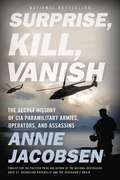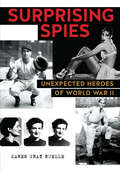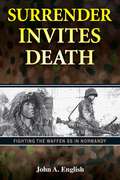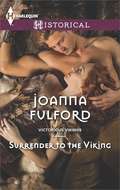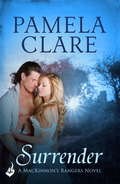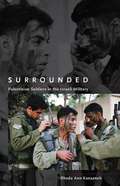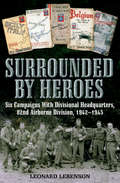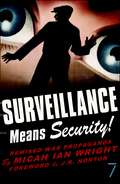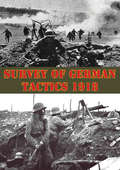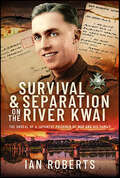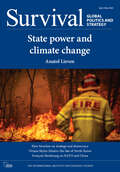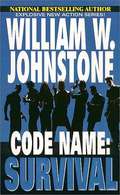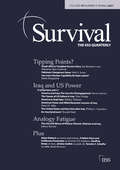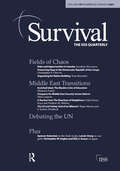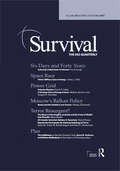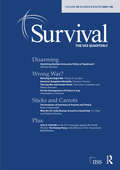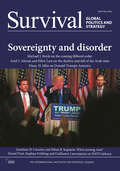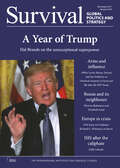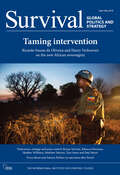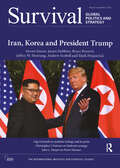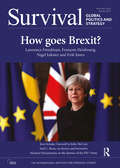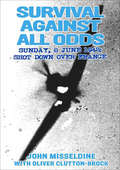- Table View
- List View
Surprise, Kill, Vanish: The Secret History of CIA Paramilitary Armies, Operators, and Assassins
by Annie Jacobsen*The USA Today bestseller* Surprise... your target.Kill... your enemy.Vanish... without a trace.From Pulitzer Prize finalist Annie Jacobsen, the untold story of the CIA's secret paramilitary units. When diplomacy fails, and war is unwise, the president calls on the CIA's Special Activities Division, a highly-classified branch of the CIA and the most effective, black operations force in the world. Originally known as the president's guerrilla warfare corps, SAD conducts risky and ruthless operations that have evolved over time to defend America from its enemies. Almost every American president since World War II has asked the CIA to conduct sabotage, subversion and, yes, assassination. With unprecedented access to forty-two men and women who proudly and secretly worked on CIA covert operations from the dawn of the Cold War to the present day, along with declassified documents and deep historical research, Pulitzer Prize finalist Annie Jacobsen unveils-like never before-a complex world of individuals working in treacherous environments populated with killers, connivers and saboteurs. Despite Hollywood notions of off-book operations and external secret hires, covert action is actually one piece in a colossal foreign policy machine.Written with the pacing of a thriller, SURPRISE, KILL, VANISH brings to vivid life the sheer pandemonium and chaos, as well as the unforgettable human will to survive and the intellectual challenge of not giving up hope that define paramilitary and intelligence work. Jacobsen's exclusive interviews-with members of the CIA's Senior Intelligence Service (equivalent to the Pentagon's generals), its counterterrorism chiefs, targeting officers, and Special Activities Division's Ground Branch operators who conduct today's close-quarters killing operations around the world-reveal,for the first time, the enormity of this shocking, controversial and morally complex terrain. Is the CIA's paramilitary army America's weaponized strength, or a liability to its principled standing in the world? Every operation reported in this book, however unsettling, is legal.
Surprising Spies: Unexpected Heroes of World War II
by Karen Gray RuelleWould you spy for your country? Discover the World War II spies who lived among the shadows and the ones who lived in the limelight--disguised in plain sight!Josephine Baker. Virginia Hall. Roy Hawthorne. These are but a few of the daring spies who risked it all to deliver and protect crucial intel for the Allied powers. From housing refugees and resistance members while extracting secrets from diplomats to developing a groundbreaking, war-changing code and keeping it top secret for over twenty years, the actions of these legendary World War II spies are unbelievable but true. This thoroughly researched collection of biographies profiles several courageous individuals who resisted the Axis Powers via espionage and heroism. Includes numerous photos and features such fascinating accounts like that of Moe Berg, a major-league baseball player and potential assassin; Noor Inayat Khan, a Sufi princess and wireless operator; and Juan Pujol Garcia, a storyteller and double agent. Also features sections on invisible ink, ciphers and codes, resistance fighters, and infamous missions such as Operation Mincemeat.Back matter includes a time line, source notes, a bibliography, recommended reading, online resources, and an index.
Surrender Invites Death
by John A. EnglishWhat it was like to fight Hitler's ideological troops in Normandy starting on D-Day, June 6, 1944.
Surrender to the Viking
by Joanna FulfordA warrior bride in the Viking's bed... A hot-tempered redhead with a talent for sword craft, Lara Ottarsdotter has seen off many an unwanted suitor! Then the Viking warlord Finn Egilsson comes seeking vengeance on a mutual enemy, and Lara's despairing father offers him a bounty of ships and swords. The price? Finn must take Lara as his wife. Finn has no wish to endure marriage again, yet his reluctant bride fires his blood with one passionate kiss. Her courage means she will never yield in battle, but soon all he wants is her ultimate, willing surrender-in the marriage bed! Victorious Vikings No man could defeat them. Two women would defy them! "Nobody does Vikings as well as Fulford." -RT Book Reviews on Defiant in the Viking's Bed
Surrender: MacKinnon's Rangers 1 (MacKinnon's Rangers)
by Pamela ClarePamela Clare brings her expert plotting, sizzling chemistry and thrilling adventure to her sweeping MacKinnon's Rangers series, in the grand tradition of The Last of the Mohicans, perfect for fans of Maya Banks, Monica McCarty and Zoe Archer.They were a band of brothers, their loyalty to one another forged by hardship and battle, the bond between these Highland warriors, rugged colonials, and fierce Native Americans stronger even than blood ties.Iain MacKinnon had been forced to serve the British crown, but compassion urged him to save the lovely lass facing certain death at the hands of the Abenaki. He'd defied his orders, endangered his brothers, his men and his mission, all for a woman. But when he held Annie's sweet body in his arms, he could feel no regret. Though he sensed she was hiding something from him, it was too late to hold back his heart. In love and war, there are times when the only course of action is... Surrender.Be swept away by the other sexy MacKinnon's Rangers in Untamed and Defiant. Or take a wildly romantic ride with Pamela Clare's I-Team: Extreme Exposure, Hard Evidence, Unlawful Contact, Naked Edge, Breaking Point, Striking Distance, Seduction Game.
Surrounded
by Rhoda Ann KanaanehAn estimated 3,000 Palestinian citizens of Israel currently volunteer to serve in the Israeli military, a force fighting other Palestinians just miles away in occupied territories. Surrounded takes a close look at this controversial group of soldiers, examining the complex reasons these people join the army and the wider implications of their decisions in terms of security and citizenship. Most observers perceive a clear and powerful divide in the political tensions and open hostilities between the State of Israel and the Palestinian people, but often fail to notice those who straddle this divide—Palestinian citizens of Israel. These soldiers comprise no more than half a percent of this population, but their stories provide a powerful vantage point from which to consider a question faced by all Palestinians in Israel: to what extent are they, in fact, Israeli? Surrounded contains over seventy interviews with soldiers, and provides a unique glimpse of their conflicting experiences of acceptance, integration, and marginalization within the Israeli military. Concluding with comparisons to similar situations around the world, the book upends nationalist understandings of how wars and those who fight in them work. A key to a more complex understanding of ethnic conflict, this gripping and revealing look at a select group of soldiers will immensely alter ideas about the reasons why people choose to fight, particularly on "the wrong side" of a war.
Surrounded by Heroes: Six Campaigns with Divisional Headquarters, 82d Airborne, 1942–1945
by Leonard LebensonThis WWII memoir offers a rare behind-the-scenes view of the 82nd Airborne and its heroic contributions to Allied victory in Europe and Africa. Joining the army in 1942, Leonard Lebenson was recruited into the 82nd Airborne for his skills as a typist and draftsman. Lebenson thus gained a ringside seat for some of the greatest campaigns of World War II—from the invasions of North Africa, Sicily, and France, to the Netherlands, the Bulge, and the drive on Berlin. Throughout the campaigns, Lebenson was at the division&’s nerve center, typing orders, drafting battle maps, and acting as liaison. A rare enlisted man with top-secret status, he was in the room with Gen. Patton, Field Marshal Montgomery, &“Jumpin&’ Jim&” Gavin, and other luminaries who came through headquarters. But Lebenson also saw battle up close—by ship, plane, glider, parachute, and Jeep. With the rest of the All American Division, he was on the ground in Africa and the Ardennes, facing ever-present enemy fire. Rising from private to master sergeant, Lebenson thought that he had &“the best job in the army.&” In this revealing memoir, however, he never fails to give full credit to the men on the firing line who suffered the greatest hardships and casualties.
Surveillance Means Security: Remixed War Propaganda
by J. R. Norton Micah Ian WrightSubversive and incendiary, this full-color poster book reworks classic war propaganda to comment on corporate corruption, domestic spying, election fraud, gay marriage, blind patriotism, the "War on Terror," and surveillance in America today.With laughs and jeers, Wright's distinctive artwork and astute political commentary offers timely and clever insight into the state of post-9/11 America. Surveillance Means Security! is the hilarious follow-up to Wright's previous books of reworked propaganda posters, You Back The Attack! We'll Bomb Who We Want! and If You're Not A Terrorist ...Then Stop Asking Questions.
Survey Of German Tactics 1918
by Staff U.S. ArmyThe First World War is often represented as a stolid slugging match of opposing trench lines being pounded by massed artillery, however, the German offensives of 1918 broke through the British lines with great and dramatic success. The German High command could not hope to match the Allies for manpower which had allowed them to ruthlessly push forward at the Somme and Passchendaele or compete with the new weapon of the war - the Tank. The German generals strained every resource and innovated their tactics to break through the trench lines; the solutions are still in use today as the keys to battle success; infiltration, operational secrecy, intense but short hurricane bombardments, dedicated elite stormtroops, concentration of effort, air supremacy. The American Staff were determined to learn from their opponent's success and documented all of the tactics that had worked so well; they produced a formidable treatise of tactics and strategic insight.
Survey for Assessing Racial/Ethnic Harassment and Discrimination in the U.S. Military
by Terry L. Schell Coreen Farris Miriam Matthews Kristie L. GoreTo help the U.S. Department of Defense (DoD) estimate the percentage of service members who experienced racial or ethnic harassment or discrimination in the past year, RAND Corporation researchers, with feedback from external experts and DoD representatives, developed a survey instrument. The authors of this report describe the instrument-development process, the instrument itself, and recommendations to support its use.
Survival & Separation on the River Kwai: The Ordeal of a Japanese Prisoner of War and His Family
by Ian RobertsEric Roberts was conscripted in 1939 into the 1/5 Sherwood Foresters. After service in France and evacuation from Brest in 1940, the Battalion were sent to the Far East arriving in Singapore three weeks before the surrender. Eric became a prisoner of the Japanese and was sent to the Burma-Thai Railway. His Commanding Officer was Lieutenant Colonel Lilly who was later to become the inspiration for Colonel Nicholson in the film Bridge on the River Kwai. Eric’s fiancée, Eunice Lowe, learnt of his capture by chance from a friend. Amidst speculation that Eric had escaped, Eunice began a campaign to learn the truth but it was not until 26 May 1943 that she received confirmation that he was a POW. From 1942 to 1945, while suffering extreme hardship and abuse from his captors, Eric was permitted to send just three postcards. Despite Eunice writing every week, only a handful were received by him in late 1944. After liberation, Eric returned home and married Eunice in 1946. Fortunately, Eric wrote a graphic memoir of his captivity in the post-war years and Eunice’s correspondence has been preserved. The two combined make for an unusual and moving record of a young couple’s testing yet very different experiences.
Survival (April-May 2020): State Power and Climate Change
by Anatol LievenSurvival, the IISS’s bimonthly journal, challenges conventional wisdom and brings fresh, often controversial, perspectives on strategic issues of the moment. In this issue: Anatol Lieven argues that strong and legitimate states remain central to any efforts to limit climate change and mitigate diseases such as coronavirus, and to maintain Western democracy Oriana Skylar Mastro warns that hereditary autocratic regimes such as North Korea’s are prone to sudden collapse, something for which policymakers should be prepared Shelby Butt and Daniel Byman contend that Russia’s attempts to undermine the West include supporting white-supremacist and other far-right groups And eight more thought-provoking pieces, as well as our regular book reviews and noteworthy column
Survival (Code Name Series #2)
by William W. JohnstoneCODE NAME: SURVIVAL A fast growing and ultra-violent racist gang is getting ready to take out New York City. But while Barrone's elite army races towards the Northeast, an outlaw biker gang-powered by a booming crystal meth business-swarms the streets of the parched American Southwest. Suddenly, Barrone's team has no choice but to jump: locked and loaded into a high speed guerrilla war of kill-or-be-killed that stretches from New Mexico all the way to the blood-soaked beaches of California...
Survival 49.1: Survival 49.1, Spring 2007
Volume 49 of Survival- The IISS Quarterly publication. (The International Institute for Strategic Studies) First published in Spring 2007. Routledge is an imprint of Taylor & Francis, an informa company.
Survival 49.2: Survival 49.2 Summer 2007
by Steven Simon John Buck Jeffrey Mazo Dana Allin Bruno Tertrais Ellena JamieFirst published in 2007. This book explores the complicity of democratic states from the global North in state terrorism in the global South.
Survival 49.3: Survival 49.3 Autumn 2007
by Yezid SayighSurvival, the Institute of Strategic Studies' quarterly journal, is a leading forum for analysis and debate of international and strategic affairs. With a diverse range of authors, eight to ten articles per issue, plus thoughtful reviews and review essays, Survival is scholarly in depth while vivid, well-written and policy-relevant in approach. Shaped by its editors to be both timely and forward-thinking, the journal encourages writers to challenge conventional wisdom and bring fresh, often controversial, perspectives to bear on the strategic issues of the moment.
Survival 49.4: Survival 49.4, Winter 2007
by Dana AllinSurvival, the Institute of Strategic Studies' quarterly journal, is a leading forum for analysis and debate of international and strategic affairs. With a diverse range of authors, eight to ten articles per issue, plus thoughtful reviews and review essays, Survival is scholarly in depth while vivid, well-written and policy-relevant in approach. Shaped by its editors to be both timely and forward-thinking, the journal encourages writers to challenge conventional wisdom and bring fresh, often controversial, perspectives to bear on the strategic issues of the moment.
Survival 58.2
by The International Institute for Strategic StudiesSurvival, the bi-monthly publication from The International Institute for Strategic Studies, is a leading forum for analysis and debate of international and strategic affairs. With a diverse range of authors, thoughtful reviews and review essays, Survival is scholarly in depth while vivid, well-written and policy-relevant in approach. Shaped by its editors to be both timely and forward-thinking, the publication encourages writers to challenge conventional wisdom and bring fresh, often controversial, perspectives to bear on the strategic issues of the moment.
Survival 58.6
by The International Institute for Strategic StudiesSurvival, the bi-monthly publication from The International Institute for Strategic Studies, is a leading forum for analysis and debate of international and strategic affairs. With a diverse range of authors, thoughtful reviews and review essays, Survival is scholarly in depth while vivid, well-written and policy-relevant in approach. Shaped by its editors to be both timely and forward-thinking, the publication encourages writers to challenge conventional wisdom and bring fresh, often controversial, perspectives to bear on the strategic issues of the moment.
Survival 59.6
by The International Institute for Strategic StudiesSurvival, the bi-monthly publication from The International Institute for Strategic Studies, is a leading forum for analysis and debate of international and strategic affairs. With a diverse range of authors, thoughtful reviews and review essays, Survival is scholarly in depth while vivid, well-written and policy-relevant in approach. Shaped by its editors to be both timely and forward-thinking, the publication encourages writers to challenge conventional wisdom and bring fresh, often controversial, perspectives to bear on the strategic issues of the moment.
Survival 60.2
by Erik JonesSurvival, the bi-monthly publication from The International Institute for Strategic Studies, is a leading forum for analysis and debate of international and strategic affairs. With a diverse range of authors, thoughtful reviews and review essays, Survival is scholarly in depth while vivid, well-written and policy-relevant in approach. Shaped by its editors to be both timely and forward-thinking, the publication encourages writers to challenge conventional wisdom and bring fresh, often controversial, perspectives to bear on the strategic issues of the moment.
Survival 60.4
by The International Institute for Strategic StudiesSurvival, the bi-monthly publication from The International Institute for Strategic Studies, is a leading forum for analysis and debate of international and strategic affairs. With a diverse range of authors, thoughtful reviews and review essays, Survival is scholarly in depth while vivid, well-written and policy-relevant in approach. Shaped by its editors to be both timely and forward-thinking, the publication encourages writers to challenge conventional wisdom and bring fresh, often controversial, perspectives to bear on the strategic issues of the moment.
Survival 60.6
by The International Institute for Strategic StudiesSurvival, the bi-monthly publication from The International Institute for Strategic Studies, is a leading forum for analysis and debate of international and strategic affairs. With a diverse range of authors, thoughtful reviews and review essays, Survival is scholarly in depth while vivid, well-written and policy-relevant in approach. Shaped by its editors to be both timely and forward-thinking, the publication encourages writers to challenge conventional wisdom and bring fresh, often controversial, perspectives to bear on the strategic issues of the moment.
Survival Against All Odds: Sunday, 8 June 1942: Shot Down Over France
by John Misseldine Oliver Clutton-BrockA Royal Air Force pilot recounts his harrowing wartime experiences, including being shot down over occupied France, in this thrilling WWII memoir. Born in North London in 1922, John Misseldine enlisted in the Royal Air Force as soon as he turned eighteen. After training in California, he flew fighters with 611 Squadron, led by the legendary Battle of Britain veteran D.H. Watkins. Then, on June 8th, 1942, Misseldine was shot down over Nazi occupied northern France. For more than two months, Misseldine was on the run from the Gestapo, aided and abetted by the French resistance and British Intelligence. Journeying south, he eventually made his way to Gibraltar and escaped back to the British Isles. Misseldine was later commissioned as a pilot officer and posted to Algeria to ferry new Spitfires and Hurricanes to front-line squadrons supporting the Eighth Army. It was there that he met and married a French girl, Mauricette. Sixty-four years later, they are still together.
